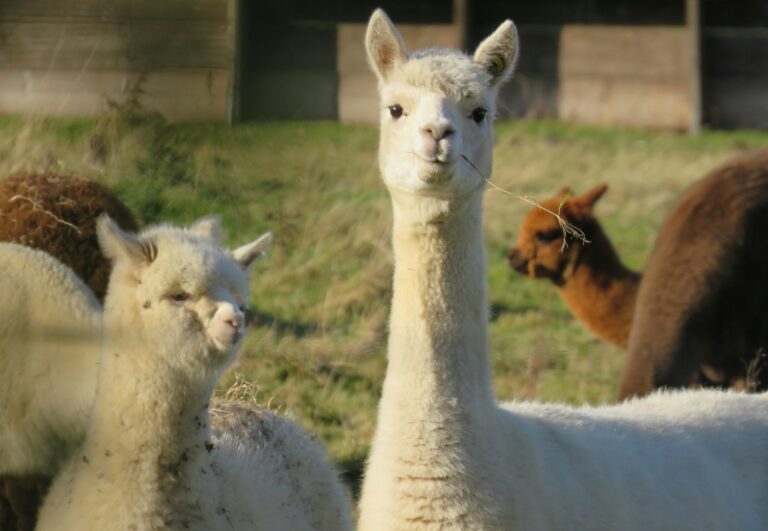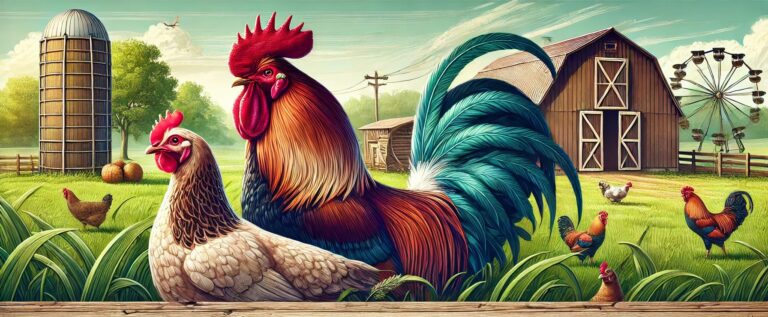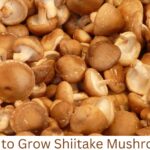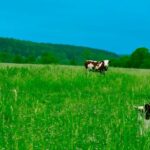Email: blogagri2@gmail.com
Angora Rabbits: The Source of the World’s Softest Wool
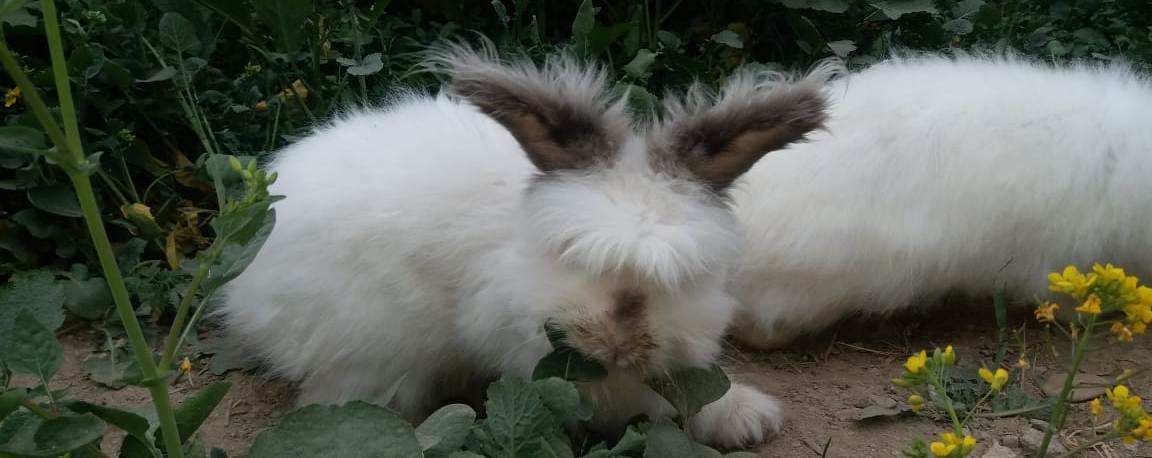
Have you ever thought about what animal gives the best wool in the world? Then, I would like to introduce you with the Angora rabbits and with mother nature’s biggest invention! These adorable animals create a sophisticated cut popular for its warmth and these rabbits have so much more to offer than just their appealing wool. But now you might wonder, what else do they provide? In this comprehensive guide, we will explore the following aspects of Angora rabbits:
- Get to know the different breeds of the Angora rabbits and their main features
- Explore the properties that Angora wool is made of making it so exquisite
- Dive into the history of this fiber and its culture
- Get to understand the moral aspects of Angora wool production Join us as we try to unlock the secret realm of Angora Rabbits that is adored by a fiber lover, an animal lover or someone just seeking out their curiosity!
Angora Rabbits History And Its Origin
In modern day Turkey, the story of Angora rabbits begin in the legendary city of Ankara. These fluffy creatures have a rich history of several centuries that spans from the magical rabbit fur coats to its gentle nature.
Ancient Beginnings
Angora rabbits are believed to have first emerged in the region of Ankara during the Ottoman Empire. Unfortunately, the details of their origin are still unknown. However, the records suggest that they were first bred for their wool in the 6th century.
European Discovery
In the mid-18th century, Angora rabbits became popular among European nobility. French traders admired these rabbits and imported them to France where they were adored by aristocrats due to their silky fur.
Global Spread
Up until the 19th century, Angie rabbits made their way across Europe, where they were bred in Germany and England, and the characteristics along with the wool was enhanced.
Modern Era
Today, Angora rabbits can be found across the globe in various breeds and forms. The will is still one of the most preferred fibers in the market due to the warmth and comfort it provides.
💡 Key Takeaway: Angora wool rabbits have deep interfaces with turkey, and are world renowned for their incredibly soft wool.
From Turkey to Global Popularity
The Angora bunny story starts in Turkey but takes a diverse turn on a global scale. It is an amalgamation of cultural intersection and economic prospects.
The European Fascination
As soon as Angora wool was introduced to the European market, the nobility took a liking to it which led to a huge mass demand. This resulted in Angora rabbits to quickly propagate across Europe. France and England seized the opportunity and started breeding programs in the 18th and 19th century.
Crossing the Atlantic
American breeders fetched Angora wool in the early 1900s. As Amwreica’s textile industry started emerging, breeders saw the potential to domesticate them and increase the rabbit population.
The Chinese Textile Boom
Over the past decade, China has contributed significantly to the Angora wool industry. The boom in the Chinese textile industry has enabled them to practice mass angora rabbit farming which has contributed significantly to the global market for this luxury fiber.
💡 Conclusion: The story of Angora australia rabbits moving from Turkey to being globally wide known revolves around the rise of the textile and industrial growth in the US, China, and Europe.
Characteristics of Angora Rabbits
If you’re looking for an adorable rabbit breed then Angora should be at the very top of your list. With their exceptionally gentle temper, angora rabbits possess features different than other rabbit breeds, making them a gentler choice for families.
Luxurious Coat
Rabbits angora is hand known for their stunning wool coat. However, Just like other animal coats, their fur also requires regular maintenance as it could mat and go up to 12 inches in length, giving them an even more luxurious look. Their wool comes in different colors such as white, black, brown and grey.
Size and Weight of Angora Rabbits
The size of angora rabbit can be determined by breed averaging between 5 to 12 pounds. Meanwhile, optimizing the weight for giant Angora rabbits should be approximately around 20 pounds. In addition to this, angora’s have compact well maintained bodies ensuring a rounder plushy look.
PERSONALITY OF ANGORA
While angora’s may have a calm personality, they are still social animals which makes them extremely interactive with their owners. If trained and cared for correctly, an angora rabbit is bound to be a great pet. But in certain situations, angoras may exhibit stress such as lack of attention or poor handling.
Grooming Needs
Angora rabbits have a very dense and long fur coat which requires them to be groomed regularly. It is ideal to groom the rabbit using a brush 2-3 times a week to minimize matting and also maintain the condition of the coat. A few owners might want to keep their rabbits hair trimmed to avoid such maintenance.
Health Considerations
When compared to other rabbits, Angora rabbits are quite healthy, however, there are certain conditions that they are prone to, mostly due to their fur type. They are known to suffer wool block, this happens when ingested fur piles up in the digestive system. Taking care of their coats regularly and feeding them properly might help in this matter.
💡 Key Takeaway – Angora rabbits are distinct from the other breeds of rabbits because of their beautiful fluffy coat, temperament and most importantly because of their dishevelled hair.
Unique Features of Angora Wool
Angora wool is widely considered a beautiful natural fiber, ‘textile experts are known to remark as one of the most extraordinary natural fibers’. So what exactly differentiates this wool from the rest:
Incomparable Softness
Most people are aware that angora wool stands out due to its unique characteristics however few are cognizant that angora wool is one of the softest fiber. It has a fine thickness which on average is between 11 to 16 microns which makes angora fiber sensational against the skin. This incredible softness is difficult to achieve with most other natural fibers which explains why angora is so in demand in the textile.
Exceptional Warmth
Even though it is very light, angora wool has good insulating properties. Each fiber has a hollow center that holds air, forming a thermal barrier without the added bulk. This distinct feature makes angora wool the best option for clothing in cold weather.
Hypoallergenic Properties
Angora has been found to be somewhat tolerable to many who are allergic to other kinds of wool. Due to the fine fibers that make up the wool, there is less irritation on the skin and therefore it has more popularity with people with sensitive skin.
Luxurious Appearance
Due to the fluffy texture and the slight shine of the fur angora wool provides, clothes made from this precious fur look lavish and classy. This eye catching look helps in enhancing its value as one of the most expensive fibers in the clothing industry.
💡 Key Takeaway: Due to it’s many unmatched qualities, for instance it’s softness, warmth, anti allergy properties and the above mentioned sophisticated look, angora wool is among the top fibers in the textile industry and is highly valuable.
Different Breeds of Angora Rabbits
Angora rabbits have several different breeds, all of which have different features and different qualities in wool production. Let’s look at the most common breeds and their specific characteristics.
English Angora
The English angora is characterized by a heavy garment of wool on its head, ears and face. This breed has very high quality fleece, thus, it is in great demand in the textile industry.
French Angora
The French angora wool has a different texture than that from the English which is quite matted. The French Angoras are less cause to mat meaning that these are easier to care for. This breed produces wool although not as much as what the English variety can produce.
Giant Angora
As the name suggests, Giant Angoras are the largest of the Angora breeds. They produce an excellent fiber which is popular with manufacturers of wool. The fibre is however slightly less fine than that from the other Angora breeds.
Satin Angora
Satin Angoras have shiny wool which makes them relatively more expensive to purchase. The wool from this breed is of a greater lustre compared to the other types of Angora rabbit bred wool. Overall, their wool is of super quality even though they yield less.
Each breed of Angora rabbit produces a different type of wool that will serve the different needs of the textile sector. Depending on the breed of the angora, the type of wool and fibre which is to be produced and what it will be used for determines the breed.
💡 Key Takeaway: There are four species under the Angora rabbit, those include, English, French, Giant and Satin and all have produced different types of wool with distinct properties.
Read Also; Hens vs Roosters
The Angora Wool Production Process
We all know that rabbits have fur, and clearly those rabbits have coaxed some ads for themselves globally, but the process of turning rabbit fur into wool is intricately more challenging and focus consuming while being peaceful in the sense that involves no violence. Let us get to the ins and outs of the procedures that go into turning rabbit wool into fiber.
Wool Shearing Techniques
There are two methods when it comes to gathering angora wool:
1. Shearing: Angora rabbit’s fur is gently clipped down to the surface of the skin by using electric clippers, once every 3 to 6 months post washing.
2. Plucking: There’s a bit of controversy when it comes to this procedure because to some people this process might be deemed as barbaric, but basically this procedure involves pulling out loose fur from the rabbits shedding season, there‘s no concrete evidence corollary to the humane impact of this procedure, so it’s ambiguous really.
Sorting and Cleaning
After the first procedure is done there are a few more things that are done which vary on the quality of the wool, colour and length, firstly wool is put through the washing cycle and any dirt or mud stuck to the fabric is removed, this is important because dirt is isolator and would maintain heat but the purpose of angora wool is to provide warmth.
Clearing the Lanes
The clean angora wool is spun into fabric through different components::
- Carding: Heavily relying on brain power this procedure of angora wool would help in positioning different anchors onto the chains and fabric without the use of any complex instruments.
- Spinning: The twisted fibers are made into yarn either by hand or by use of spinning machines, and this forms the third step of carding.
- Blending: To enhance its tenacity, angora wool is frequently mixed with sheep’s wool or even man-made fibers in order to reduce the costs.
Dyeing and Finishing
The yarn may also be dyed to specific colors and treated in any other way required in the end product. Care has to be employed because the unique characteristics of angora wool have to be preserved.
💡 Key Takeaway: The process of production involves lots of care, cleaning, and processes to get silky fibers out of the rabbit fur without compromising its properties.
Ethical Concerns in Angora Wool Production
You see, angora wool being made has been a controversial topic as the said commodity raises the regard of animal welfare. Regarding the same, many animal right advocates has flagged the treatment of angora rabbits who are high bred in the industry.
Confined Living Conditions
Since Angora rabbits are rarely handled, they are raised in small metal mesh cages which greatly constrains their ability to carry out normal behaviours. These small areas inhibit the rabbit’s ability to jump, stretch and socialize, resulting in both mental and physical pain.
Painful Harvesting Methods
Some producers utilize a technique known as ‘plucking’ to collect angora fibers. This method can cause harm to the rabbits and induce stress as well. Although there are more kind shearing techniques, it is not used by all.
Lifetime of Misery
Rabbits at industrial angora farms are typically never treated well. They sadly go through cycles of painful harvesting methods where they are not taken care of at all. This treatment can be quite harmful as in reality rabbits are social creatures and such altercations can lead to poor health and shortened lives.
Struggle for Keeping A Battle Free or Cruelty Free Wool
With the increase of knowledge and understanding many people and fashion organizations are moving towards cease of using angora wool due to the animal cruelty it has been causing, this change inspires better working standards for the sector as well as creation of cruelty free alternatives.
💡 Key Takeaway: The main controversy pertaining to the regard of ethical use of angora wool is the humane use of angora bunnies, the conditioning which involves plucking the bunnies fur and over shearing them.
How is Angora Rabbits Wool Used in the Textile and Fashion
For as long as Angora wool has been in the fashion and textile vision it has been wanted due to how soft and warm it feels. This strong fiber is used in several luxurious goods which makes it appealing for most designers and buyers.
Luxury Knitwear
Angora wool makes the best sweater, cardigan and scarf ensemble. It is lightweight and has great insulation properties making it an ideal choice for winter clothing. Designers tend to employ the angora blend to achieve an elegant and warm look in their winter high fashion collections.
Accessories and Trims
Moreover, due to the rich and fluffy texture of angora wool, it can be used to add depth and luxury into an accessory. Some of the accessories that you can expect to find this wool in are:
- Fur on coasts and jackets
- Hats and berets
- Gloves and mittens
- Shawls and wraps
Blended Fabrics
In an effort to cut costs, angora wool is mixed with other material to make it more durable. A few examples are:
- Wool – For warmth and support.
- Cotton – For breathability and comfort.
- Silk – For its smooth glowing look.
All these blends work together to make fabrics that embody the best qualities from each fiber making them great materials for different kinds of clothing.
Home Textiles
Angora wool finds its way into luxurious home textiles Soft warm blankets Decorative pillows High end upholstery fabrics
Niche Markets
Angora wool is also popular in specialized markets Baby clothing and blankets, especially sensitive to the skin, are highly sought after for their Silk-soft Touch Therapeutic clothes, however, are also in great demand because of the warmth and comfort they provide.
💡 Key Takeaway: The technology in Angoras is meant to be Multi-purpose and desirable which could explain why its fabric is a prerequisite in a lot of high-end fashion items as well as accessories and even home textiles this is why it is usually combined with other materials.
Angora Wool vs Other Luxury Fibers
when it comes to luxury fibers, angora wool is different from other luxury fibers for its unique features. Compare this to other expensive fibers such as Cashmere or Mohair or Angora Goat Hair.
Softness and Warmth
Angora wool is noted for the extreme softness of its fibers. With an average fiber diameter of 11-16 microns, it is among the least coarse among natural fibers. In relation to: Cashmere 14-19 mohears 25-40 mohair angora goat hair over 20 – 25 Angora hair fibres have hollow insides and this increases their warmth, when compared to solid fibers, or strands, angora wool traps more air making angora wool a better thermal insulator.
Durability and Care
While angora wool possesses gentleness, it does not hold up nearly as well as other luxury fibers:
- Cashmere shows greater endurance and is less finicky
- Mohair is exceedingly strong and durable
- Sheared angora goat(s) are more resilient and less likely to shed fibers.
Appearance and Texture
Let us talk about the appearance of angora wool now:
- Angora goat hair is glossy with a velvety texture.
- Cashmere has a flatter and glossier surface.
- Mohair has a healthy shine and has a rougher texture.
Cost and Availability
Angora wool is labor-intensive to produce and angora rabbit farming poses ethical issues, which explains why it costs more money and is difficult to get.
💡 Key Takeaway: Among luxury fibers, Angora wool is the most gentle and warmest however, it is more expensive and less resistant as compared to cashmere or mohair.
The Angora Wool Industry Today
Factors such as changing consumer behavior, ethical considerations, and the global marketplace have impacted the angora wool industry in the past few years. In this section, we will assess the status of the production and trade of this textile material.
Global Production Landscape
Statistics indicate that China is the most dominant angora wooled nation in the world, accounting for about 90% of the supply. The boom in the Chinese textiles industry kept this dominance intact. However, there is production of angora wool in France, Germany and Chile among other nations though the supply is less compared to China.
Market Challenges and Shifts
In recent years, the angora wool industry has been criticized for its animal welfare practices, and as a result many fashion companies have refused to use angora wool as it would turn consumers away from buying their products. Thus, the demand decreased. This change has prompted producers to upgrade their supply chain and the way they manufacture their goods to be both ethical and effective.
Quality and Pricing
On the other hand, Angora wool has established itself as a popular textile for the production of high-end goods despite the many problems in the industry. The high-quality angora wool is one of the most expensive, and by some estimates, the best angora fibers can be worth $10-15 per ounce. Such pricing demonstrates the borderline involvement and delicate nature of angora wool production.
Sustainable and Ethical Production
Producers have stepped to alleviate the suffering of animals and introduced a more humane way of harvesting. Although these ethical production systems are expensive, there seems to be a market for Angora products harvested without cruelty with consumers ready to pay higher prices
Future Outlook
There are qualified guesses that the future of the angora wool industry mainly lies in the addressing of the ethical concerns while figuring out how to maintain the business quality that serves as the appeal. Improvements in the techniques of production and the intention to make the supply chain more transparent may assist in regaining consumers’ trust and stabilizing the demand for this premium fiber.
💡 Key Takeaway: Currently, the angora wool industry is facing difficulties in trying to achieve a balance between the ethics of the production process and the demand in the market, while China is leading the angora global production and the market where there is a growing tendency of consumers towards sustainable and kinder practices.
Major Producers and Market Trends
There has been material shifting in the angora wool business in the world in the most recent timeframe, and China is reported to have taken the lead among them. The textile industry boom in Chinese industry as of late has drastically altered the landscape while placing China as the top cultivator and exporter of angora wool in the world.
China’s Dominance
Through its lower expenditure on labor and the ability to manufacture on such a scale, China has been able to acquire quite a large chunk of the market share. Over 90% of the entire global share of angora wool is based in China where the wool is sourced from local and small scale farmers.
Other Key Players
Aside from China which has an overwhelming grasp of the industry, countries such as France, US and Chile are working to grow the global supply of Angora wool. With their involvement, these countries aim to satisfy niche markets by offering high quality, and ethically sourced Angora wool pro
Market Trends
The Buffalo market has a huge demand for angora and it is continuing to grow in Persian Gulf Coutries. This means that producers must evolve in their ways of production and must change towards more humanely sourced garments.
💡 Key Takeaway: China dominates the angora wool market, but ethical concerns are shaping new trends in production and consumption.
Care and Maintenance of Angora Wool Products
The Buffalo market has a huge demand for angora and it is continuing to grow in Persian Gulf Coutries. This means that producers must evolve in their ways of production and must change towards more humanely sourced garments.
Washing Angora Wool
Caring for angora wool fabric requires a gentle touch, which basically means washing fabric with care.
- Make sure to wash in hand using cool water and a mild detergent
- Refrain from wringing or agitating since this may lead to the fabric to felt
- Make sure to rinse till all the detergent is out with cool water
- Avoid twisting or wringing as this may cause damage, gently press the fabric to remove excess water
Drying and Storing
Given that angora wool items are sensitive in terms of quality and shape, storing and drying care is pivotal:
- Place on a clean towel, make sure to avoid twisting and lay flat to enable faster drying
- When there is an intention to wear the clothing attached to a belt make sure that it is slightly reshaped with dampness.
- Both direct sunlight and heat should be avoided.
- Make sure to seasonally rotate the make up of the closet and the drawers, ensure that the clothes are folded and stored in a dry and cool place.
- Keeps moths at bay using lavender sachets or cedar blocks.
Brushing and Pilling
Angora yarn and wool are known for their fluff, while on the other hand pilling is regarded as a major dent for any material, however a regular schedule of brushing keeps the fabric in use and defluffs the wool for a long spin:
- Gently use a brush to bring air in the fibers while incorporating soft bristles
- Pilling can easily be removed with a fabric shaver or a sweater stone
Professional Cleaning
Delicate items that contain stubborn stains can ideally be dry cleaned. When considering, hire professionals who have ample experience and ideally ask them loosen up the fibers on the angora wool items.
💡 Key Takeaway: Angora fabric is known for its soft and delicate touch, gentle hand washing, careful drying, and regular brushing is essential to maintain the integrity of the fabric and ensure a smooth bottom line, marca will be hand in glove with the process and will provide ease to the users.
Health Considerations for Angora Rabbits
Angora rabbits are known for their silky fur which means that they require special treatment by their owners and without their owners knowing how to tend to their fur properly, these rabbits a lot of the time find it hard to maintain their fluff. There are many things that owners of angora rabbits should take into account including the health issues their pets may experience and how to go about mitigating their effects.
Common Health Issues
Eye Disease
Eye infection is common due many Angora rabbits suffering from long hair so it would be ideal for owners to groom their pets often around the eye area to reduce the chance of eye infections or irritation from taking place.
Dental Problems
Angora rabbits experience a lot of problems with their teeth growing too much which can make eating painful so it is important that their teeth are checked regularly so that they do not grow out too much and into eating problems.
Preventive Care
Regular Grooming
Everyday brushing of Angora ensures that their fur does not get matted as well as allows owners to keep an eye for any skin issues that may spring up.
Nourishment
In order for an Angora rabbit’s digestive health to be prioritized, it is essential for its owners to put it on a strict diet filled with vegetables and hay, excessive amounts of them can result in an overweight rabbit.
Lifespan and Quality of Life
The life expectancy of an Angora rabbit is anywhere between 8 to 12 years which can be increased if owners create a stress free environment coupled with regular vet visits.
Behavioral Considerations
Angora rabbits require proper socialization or they tend to get physically aggressive and if you do not have proper cherishing device then it would be best to give this breed a miss.
💡 Key Takeaway: Proper health care, including regular grooming, a balanced diet, and veterinary check-ups, is essential for maintaining the well-being of Angora rabbits and ensuring a long, healthy life.
Conclusion
This time we took an in-depth look at Angora rabbits alongside with their gorgeous wool, and it goes without saying that these cute animals are not just a pretty sight, Instead, Their unique fiber has been a subject of fascination in the textile industry for centuries due to its unparalleled warmth, however a discussion about the ethics surrounding the making of Angora wool is something the consumers need to have.
If you are someone who is interested in fashion or perhaps has a love for animals, there are alternatives that allow us to enjoy the Angora’s charm but with animal cruelty kept in mind, consider seeking out cruelty free options or angleing your way towards Angora farms which look out for the rabbits best interest. In being sensible customers, we can contribute to making the industry kinder.
FAQs
The Angora rabbit is not considered as a hypoallergenic breed, owing to its long and thick fur which is likely to shed along and tumble with allergens. But, it has been noted that some breeds of Angora rabbits may be suitable for people suffering from mild allergies.
Angora rabbits will require grooming daily a wide-tooth brush is a good tool to ensure strands don’t turn into tangled mats. Rabbits will also require additional grooming sessions at least twice a week to ensure their coats look good and remain healthy.
Angora Rabbits can be considered indoor pets along with other breeds. These types of pets are very social and can easily adjust in an indoor enviroment assuming they are given sufficient amount of exercise, room and ventilation.
n Angora rabbit tends to live for an average of 7-12 years with plenty of care provided. Such life span can be affected along with factors like exercise, nutrition, housing environment, and genetic inheritance. It is crucial for anyone hoping to keep these rabbits as pets to book regular vet appointments and attend to their care for a long and healthy life. In the case where these rabbits would not receive reasonable care would only shorten their longevity.
Although interwoven with expensive alpaca wool, Angora wool is more expensive than other luxurious fabrics because it is on the rarer side and is handmade. While on the topic of price, angora wool is expensive than cashmere and mohair however it is of compareable price to vicuna wool. Market demand and quality will determine the true cost. Its price appears to range greatly based on the variety considered.
Angora wool tends to be warm, very soft but it has a tendency of excessive shedding. In order to avoid shedding, it would be advised to mix it with other fibers which in return would also help improve the durability of the Angora blended garments. Recipe for clothes made with Angora stand strong to be hand washed or dry cleaned as this would help maintain the quality as well as avoid felting and shrinkage


